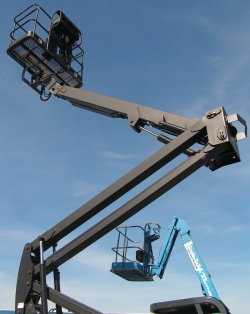
Often, when delivering aerial lift training programs, we get out to the equipment and find that its required inspections are not up to date. This is bad news. We can’t proceed with any aerial equipment without verification of current inspections. Does your company use boom or scissor lifts? Do you know when they were last inspected and how often they need to be inspected? Keep reading, we’ve got the answers…
Under the ANSI/SIA Standards A92.5 and A92.6 section 6.6(2) and the manufacturer’s requirements, equipment owners/users need to make sure that aerial lifts have had a frequent inspection at “3 months or 150 hours” (whichever comes first). This inspection must be performed by a person qualified as a mechanic on the specific type of aerial equipment or one having similar design characteristics, per ANSI/SIA A92.6 and A92.5 section 6.6.
Also, annual inspections need to be performed per ANSI/SIA A92.6 & A92.5 section 6.7; “The owner of an aerial platform shall ensure that an annual inspection is performed on the aerial platform no later than thirteen (13) months from the date of the prior annual inspection. The inspection shall be made by a person(s) qualified as a mechanic on the specific type of aerial platform or one having similar design characteristics. The inspection shall be in accordance with items specified by the manufacturer for an annual inspection. The owner shall not place the aerial platform into service until all malfunctions and problems have been corrected.”
For aerial lift users in Ontario, Canada, the above may not be applicable with respect to ANSI standards, however the applicable CSA Standards contain very similar requirements. Section 5.3.2 Periodic Inspection states “This inspection shall be performed after 200 h of use or after a period recommended by the manufacturer, whichever comes first.” Section 5.3.3 Annual Inspection states “This inspection shall be performed annually or after 700 h of use, whichever comes first.” The CSA standards go a step further by also requiring “structural” inspections of critical components to be carried out under the direction of a professional engineer 10 years after the machine’s date of manufacture and every 5 years thereafter.
Frequent and annual inspections need to be done within the time frames referenced in the ANSI and/or CSA standards but they may also have to be done more frequently if the unit is used in severe conditions that cause the parts to wear more quickly than they would under “normal” conditions. In addition, an inspection would also have to take place under the following circumstances:
- Electrical contact – such as with energized power lines.
- Shock load – sudden, intense loads on critical parts like those encountered when the machine tips over or parts of it impact or collide with fixed or solid objects, or absorb a fall arrest load.
- Damage or failure due to overloading and/or over-stressing.
- Any situation where actual or even potential damage happens due to something that could possibly weaken any part of the machine or cause the unit to become less stable.
- A change of ownership happens, unless the previous owner can provide the complete service history of the machine including maintenance and service records.
Stay safe and in compliance by keeping your aerial equipment up-to-date on its inspections!
Rob Vetter
Director of Training
IVES Training Group
[Article originally posted in our April 2013 IVES Update Newsletter]
Did you enjoy this article? Sign up for our newsletter to receive more like this!